 |  |  |  |
| Silver Lyre (c2500 BCE) from Sumerian city of Ur at British Museum. London, United Kingdom. | Silver Lyre (c2500 BCE) with reconstructed model beyond from Sumerian city of Ur at British Museum. London, United Kingdom. | Goat in a Thicket statue (c2300 BCE) from Sumerian city of Ur in Mesopotamia at British Museum. London, United Kingdom. | Box decorated with mosaics (c2500 BCE) from Sumerian city of Ur at British Museum. London, United Kingdom. |
 |  |  |  |
| Silver bull of early Bronze Age (c2300 BCE) prob. from Alaca Hüyük in central Turkey at British Museum. London, United Kingdom. | Gold necklace with flying eagles holding pendant discs (14th-13thC BC) from Turkey at British Museum. London, United Kingdom. | Spouted pottery jar painted with square with dots & bull (10th-9thC BCE) excavated from Tepe Sialk in central Iran at British Museum. London, United Kingdom. | Spouted bronze jars riveted together plus pottery imitations with clay pellets mimicking rivets (9th-8thC BCE) excavated from western Iran at British Museum. London, United Kingdom. |
 |  |  |  |
| Boundary stone carved with history of Ritti-Marduk whose chariot military campaigns made his land exempt from taxes under reign of Nebuchadnezzar I (1125-1104 BCE) from Sippar, now Iraq at British Museum. London, United Kingdom. | Stone monument with relief of father & son in cuneiform inscription (c900-800 BCE) from Marduk temple in Babylon now Iraq at British Museum. London, United Kingdom. | Black Obelisk of King Shalmaneser III of Assyria (c827 BCE) from Nimrud on which relief panels records tributes made to him by foreign kings at British Museum. London, United Kingdom. | Relief panel on Assyrian Black Obelisk of Shalmaneser III (c827 BCE) from Nimrud showing variety of ruminants given to King Shalmaneser III in tribute at British Museum. London, United Kingdom. |
 |  |  |  |
| Assyrian stela of Shamshi-Adad V (c814 BCE) from Temple of Nabu from Nimrud at British Museum. London, United Kingdom. | Assyrian human-headed winged lion (c865-860 BCE) guarding doorway of North-West Palace from Nimrud at British Museum. London, United Kingdom. | Assyrian human-headed winged lion (c865-860 BCE) guarding doorway of North-West Palace from Nimrud at British Museum. London, United Kingdom. | Facial detail of Assyrian human-headed winged lion (c865-860 BCE) guarding doorway of North-West Palace from Nimrud at British Museum. London, United Kingdom. |
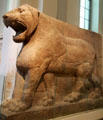 |  |  |  |
| Assyrian colossal guardian lion (c865-860 BCE) guarding doorway of Temple of ishtar from Nimrud at British Museum. London, United Kingdom. | Assyrian eagle-headed protective spirit (c865-860 BCE) guarding doorway of Temple of Ninurta from Nimrud at British Museum. London, United Kingdom. | Assyrian winged protective spirit (c865-860 BCE) guarding doorway of North-West Palace from Nimrud at British Museum. London, United Kingdom. | Assyrian eagle-headed protective spirit (c865-860 BCE) guarding doorway of North-West Palace from Nimrud at British Museum. London, United Kingdom. |
 |  |  | 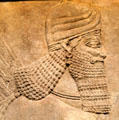 |
| Detail of Assyrian eagle-headed protective spirit (c865-860 BCE) guarding doorway of North-West Palace from Nimrud at British Museum. London, United Kingdom. | Assyrian carved panel portrays King Ashurnasirpal II under divine protection (c883-859 BCE) from North-West Palace of Nimrud at British Museum. London, United Kingdom. | Assyrian carved panel portrays King Ashurnasirpal II under divine protection (c883-859 BCE) from North-West Palace of Nimrud at British Museum. London, United Kingdom. | Detail of Assyrian carved panel head of King Ashurnasirpal II (c883-859 BCE) from North-West Palace of Nimrud at British Museum. London, United Kingdom. |
 |  |  |  |
| Assyrian lion hunt carved panel (c865-860 BCE) from North-West Palace of Nimrud at British Museum. London, United Kingdom. | Detail of Assyrian lion hunt carved panel (c865-860 BCE) from North-West Palace of Nimrud at British Museum. London, United Kingdom. | Assyrian stone relief fragment showing horses which pulled chariot (9thC BCE) excavated from Palace of Ashurnasirpal in Nimrud, Iraq at British Museum. London, United Kingdom. | Assyrian glazed terracotta tile shows king with cup & bow in procession (c875-850 BCE) from Palace of Nimrud at British Museum. London, United Kingdom. |
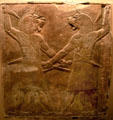 |  |  |  |
| Assyrian carved panel of protective spirits (c645-635 BCE) from North Palace of Nineveh at British Museum. London, United Kingdom. | Assyrian carved panel shows netting of deer (c645-635 BCE) from North Palace of Nineveh at British Museum. London, United Kingdom. | Assyrian carved panel shows lion hunt on horseback (c645-635 BCE) from North Palace of Nineveh at British Museum. London, United Kingdom. | Assyrian carved panel shows lion hunt scene (c645-635 BCE) from North Palace of Nineveh at British Museum. London, United Kingdom. |
 |  |  |  |
| Assyrian carved panel shows lion hunt by chariot (c645-635 BCE) from North Palace of Nineveh at British Museum. London, United Kingdom. | Assyrian carved panel shows shielded guards during lion hunt (c645-635 BCE) from North Palace of Nineveh at British Museum. London, United Kingdom. | Assyrian carved panel shows dying lion (c645-635 BCE) from North Palace of Nineveh at British Museum. London, United Kingdom. | Assyrian carved panel shows lion hunt by chariot (c645-635 BCE) from North Palace of Nineveh at British Museum. London, United Kingdom. |
 |  |  |  |
| Glazed brick guardsman (521-500 BCE) excavated from Palace of Susa, Iran at British Museum. London, United Kingdom. | Detail of glazed brick guardsman (521-500 BCE) excavated from Palace of Susa, Iran at British Museum. London, United Kingdom. | Hittite clay tablet with cuneiform writing (c1480 BCE) from Tell Atchana in south-eastern Turkey at British Museum. London, United Kingdom. | Hittite cuneiform tablet records 'Aleppo Treaty' c1300 BCE from Bigazköy in central Turkey at British Museum. London, United Kingdom. |
 | 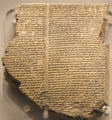 |  | 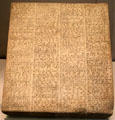 |
| Cuneiform letter plus a small addendum & their clay envelope at British Museum. London, United Kingdom. | Gilgamesh cuneiform flood tablet (written 700-600 BCE, translated 1872) relates in verse how gods sent flood to destroy world 2000 years before. Utnapishtim (like Noah) was forewarned, built an ark to preserve life, & afterward sent out birds to find dry land at British Museum. London, United Kingdom. | Cuneiform list of Assyrian synonyms (prob. prior to c600 BCE) to help scribes with early use of ditto marks at British Museum. London, United Kingdom. | Cuneiform stone tablet found in ruins of Babylon, lauds accomplishments of town's king Nebuchadnezzar (604-562 BCE) (aka East India House Inscription after company gave it to British Museum). London, United Kingdom. |
 |  | 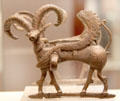 |  |
| Luristan metal idol standards (9th-8thC BCE) at British Museum. London, United Kingdom. | Luristan-style horse-bits & cheek-pieces (9th-8thC BCE) at British Museum. London, United Kingdom. | Luristan-style horse-bit in form of winged goat (9th-8thC BCE) at British Museum. London, United Kingdom. | Persian empire silver wine pourer in form of winged griffin (mid 6th-5thC BCE) possibly from Altintepe near Erzincan, Turkey at British Museum. London, United Kingdom. |
 |  |  |  |
| Persian empire silver wine pourer in form of winged griffin (mid 6th-5thC BCE) possibly from Altintepe near Erzincan, Turkey at British Museum. London, United Kingdom. | Persian or Syrian silver & gold wine drinking cup in shape of crouching bull (mid 6th-4thC BCE) at British Museum. London, United Kingdom. | Detail of crouching bull on Persian or Syrian silver & gold wine drinking cup (mid 6th-4thC BCE) at British Museum. London, United Kingdom. | Gold Achaemenid culture chariot model pulled by four horse (5thC-4thC BCE) found in Oxus River Treasure, Tajikistan at British Museum. London, United Kingdom. |
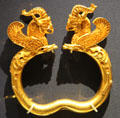 | 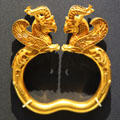 |  |  |
| Ancient Iranian Achaemenid culture gold armlets of winged monsters with griffin heads (5thC-4thC BCE) found in Oxus River Treasure, Tajikistan at British Museum. London, United Kingdom. | Ancient Iranian Achaemenid culture gold armlets of winged monsters with griffin heads (5thC-4thC BCE) found in Oxus River Treasure, Tajikistan at British Museum. London, United Kingdom. | Gold votive heads (5thC-4thC BCE) found in Oxus River Treasure, Tajikistan at British Museum. London, United Kingdom. | Gold Achaemenid culture head (5thC-4thC BCE) found in Oxus River Treasure, Tajikistan at British Museum. London, United Kingdom. |
 |  | 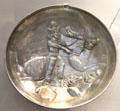 | 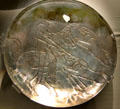 |
| Persian empire silver Achaemenid culture votive statuette (5thC BCE) found in Oxus River Treasure, Tajikistan at British Museum. London, United Kingdom. | Gold Achaemenid culture vessel in form of Turkestan barbell fish (5thC-4thC BCE) found in Oxus River Treasure, Tajikistan at British Museum. London, United Kingdom. | Sasanian Empire silver plate showing Shapur killing deer (4thC CE) from Iran at British Museum. London, United Kingdom. | Sasanian Empire silver plate showing lion hunt on horseback (5th-7thC CE) from India or Afghanistan at British Museum. London, United Kingdom. |
 |  |  | 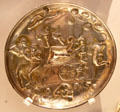 |
| Sasanian Empire glazed pottery wine pourer (rhyta) with images or rulers? & bull (3rdC CE) probably from Babylon, Iraq at British Museum. London, United Kingdom. | Sasanian Empire glass perfume & cosmetic jars (early CE) at British Museum. London, United Kingdom. | Bronze dragon (1stC CE ± 4 centuries) from Helmand, Afghanistan at British Museum. London, United Kingdom. | Silver plate showing Dionysus (2nd-3rdC CE) from Qunduz, Afghanistan at British Museum. London, United Kingdom. |
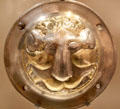 | 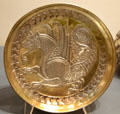 |
|
|
| Sasanian Empire silver plate shield boss in shape of lion face (6thC-7thC CE) from Iran at British Museum. London, United Kingdom. | Persian silver plate with senmurw beast of Zoroastrian mythology (7thC-early 9thC CE) possibly from India at British Museum. London, United Kingdom. |
|
|








